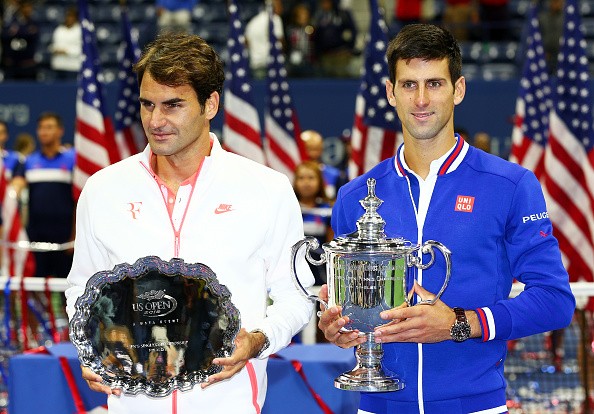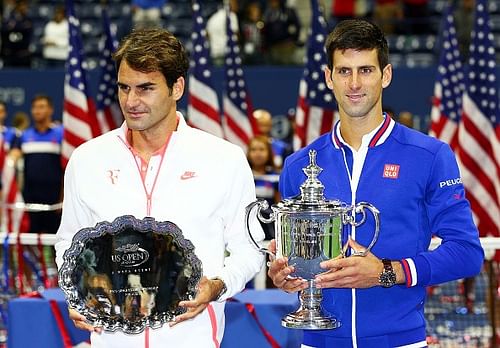
Wimbledon and Flushing Meadows: A study in contrast

In the end, there was barely a cheer for Novak Djokovic as he lifted the trophy. His beaming face reflected from the shiny US Open Trophy, but a 23,000 strong crowd barely let that reflection resonate with the chanting of his name.
They were heartbroken that Roger Federer fell at the doorstep, a fear engulfing them that he might not exactly pen the swansong Pete Sampras had scripted for himself. And as the curtains were pulled down at the Arthur Ashe Stadium, you finally realised that the fourth Grand Slam of the year was done and dusted, amidst sultry weather, occasional showers and a colourful ambience.
We could throw an innuendo or two about the surprise drone, the Nick Kyrgios antics or the Serena Williams shocker. But those would be minor details on a canvas that has so many colours that there is barely anything to connect it to its predecessor in the tennis calendar, the Wimbledon championships.
You cannot help but love a game like tennis, cruel as it may feel to the individuals who find themselves surrounded in an arena by thousands of spectators. And unlike in the green, grassy, verdant courts of Wimbledon, the spectators in New York are allowed to express themselves a little more freely. Sometimes, a lot more freely.
History will never whisper to you the simple truth that Djokovic’s nerves of steel had to put up with a lot more at this final than he did in the previous victorious campaigns this year. That's because the sheer brightness of everything that is part of the US Open masks pretty much everything else.
If Wimbledon is the poignant, graceful, quiescent elder sister, US Open is the bubbly, charming, talkative, adorable younger sibling. Flushing Meadows is the sibling who could be mischievous at times, unruly at other times, but will never fail to tug at the sleeves of your heart, compelling you to bend down on your knee and give her a peck on the cheek.
Wimbledon is the classy waltz where, unless you are well-trained in the art of social decorum, you might be left feeling a little overwhelmed, sometimes a little uninvited. The US Open, on the other hand, is the neighbourhood party where everyone is invited.
In New York, you might witness a cornucopia of heart-warming, enthralling, enlivening happenings. Take for example, the Jimmy Fallon-Justin Timberlake bromance as they coolly, almost nonchalantly, pulled off the ‘Single Ladies’ Beyonce impression – dance steps which an entire generation of pop music fans will not take more than a microsecond to identify.
Celebrities at the US Open don’t have to look dignified in Armanis. They can carry their boyish charm or girlish fervour with them, and let the old-worldly manners of the gentlemen and ladies rest in the closets of their hotel rooms.
The US Open was a canvas that was painted from a palette that had so many shades, one would lose count literally, rhetorically and metaphorically. As the camera panned across tiers upon tiers conjured around the arena, you could see, not the quiet rustle of dignity, but the buzzing energy of a rock concert. And sure, there were performances too – from bands, saxophone players and opera singers.
And the partying and dancing extended itself down to the court as well, something that would be unimaginable on the grassy courts of Wimbledon soaked in the patina of traditions. After the second round, Djokovic even invited a fan and broke into a dance jig with him.
That is how the mood of the last Grand Slam tournament continued throughout, embellished by the loud music systems that would break into something funky, something foot-tapping, making the players pause their gruelling duels for a few moments.
If the ambience was lively, so was the on-court glamour. Almost in contrast to the strict rules at Wimbledon this year, where everything had to be serenely white including the underpants, the US Open was a rebel’s paradise. At one point, when Sania MIrza and Martina Hingis were playing in the semi-final against Sara Errani and Flavia Penneta, there were eight different colours flashing through the players’ outfits.
The US Open in many ways is the players’ tournament, where they express themselves as much through their tennis as they do through their outfits. Sure, someone like a Roger Federer would still be monk-like, soothing strips of pink on an otherwise white T-shirt. But others, like Serena Williams, let themselves be wrapped in several shades and textures.
The hard courts sometimes look much fancier than the grass courts, giving themselves a character that distinguishes itself sublimely from Wimbledon. In many ways, the freedom of outfit in itself is a layer that divides the US Open from the Wimbledon unequivocally.
While the tennis played is the same, unlike in case of, say, a T20 match in contrast to a 5-day Test match in cricket, tennis becomes unique in the experience US Open offers to players and audiences alike. Like David Foster Wallace once wrote, ‘TV tennis is to live tennis what video porn is vis-à-vis feeling human love.’
That line puts into perspective the experience offered by a tournament that lets you be, soaking in the experience of something colourful. And while the traditions of Wimbledon must be preserved, the US Open elevates the personality of players and their styles to another level, amplifying the individuals they are in an individual sport, instead of trying to bridge their uniqueness with a common dress code.
When you zone into that viewpoint, the US Open does a greater service to the whole idea of tennis being a thoroughly individual sport, especially when you are talking about the singles.
Like Rohit Brijnath wrote recently, tennis can be a cruel sport, because during the toughest of times, you find yourself alone, facing your demons and your fears, sometimes doubled, maybe quadrupled by the chants of a raucous crowd supporting your opponent. But even within this cruel sport there are layers, like personalities that often taint, nay paint, the style of play, altering the experience of the audience.
While Wimbledon was like a ritual performed with utmost obeisance, the US Open was like a street carnival where the sport didn’t engulf everything, but was rather a part of a bigger festival; the sport wasn’t isolated into one monster that couldn’t be distracted, disguised or veiled by anything brighter, louder or trendier. Two different battles, two different battlefields. Djokovic aced both.
So did Mirza and Hingis, unlike many of the other contenders, but it is hard not to romance a sport that could show you so many esoteric shades all in one brief stretch of time.
Wimbledon and the US Open. The elder sibling offers a conversation that leaves you feeling wise and soothed, while a conversation with the younger leaves your life embellished with unbridled joy!